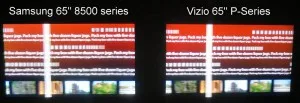Beyond HD – At CES earlier this year, Vizio announced its new P-series of UltraHD Smart TVs. On September 23rd, the product line was launched, with the TVs starting to ship immediately. I had a chance to see these products at an event Vizio held in New York City.
The P-series of TVs have a number of common key features. These include:
- UltraHD resolution (3840 x 2160)
- Direct LED backlights with zoned dimming. There are 64 zones in the sizes from 50” to 65”, with 72 zones in the 70” model. (More about this later)
- They are Smart TVs designed to support UHD streaming from providers like Netflix and later this year, Amazon Instant Video and UltraFlix
- HEVC H.265 codec and 802.11 ac dual-band WiFi for faster streaming
- HDCP 2.2 support
- Vizio’s Clear Action Rate 960 provides an effective refresh rate of 240 Hz (More about this later)
- A Vizio-engineered V6 six-core processor, comprised of a quad-core GPU plus dual-core CPU
- The Vizio VM50, a dedicated motion and picture-processing engine that runs on the V6 processor.
- State of the art upconversion from HD to UHD resolution
- Pricing that is apparently already upsetting competitors like Samsung
o Vizio 50” P-Series (P502ui-B1) $999.99
o Vizio 55” P-Series (P552ui-B2) $1,399.99
o Vizio 60” P-Series (P602ui-B3) $1,699.99
o Vizio 65” P-Series (P652ui-B2) $2,199.99
o Vizio 70” P-Series (P702ui-B3) $2,499.99
The event featured all five members of the P-series line on display, showing native UltraHD content. Of course, they all looked good. Quite frankly, every UHD TV I’ve ever seen set up by the manufacturer and showing native UHD content chosen by the manufacturer has looked good to me.
Perhaps more interesting were the three side-by-side comparisons Vizio had set up comparing the P-series to significantly higher priced UltraHD Samsung sets. In each pair, the Vizio 65” unit at $2200 was compared to a Samsung set, such as the 65” 8500 series UHD set with a MSRP of $4999. Of course, nobody pays the MSRP, but Best Buy is currently listing the UN65HU8550FXZA for $3,200, $1000 more than the Vizio set, which Best Buy was showing already at its MSRP.
Motion on a Samsung 120Hz TV compared to the Vizio 240Hz TV.
The first side-by-side demonstration involved motion, as shown in the image. All the objects in this image were moving right to left at various speeds, with the vertical white bar the fastest. As the bar swept over some of the underlying objects, its presence seemed to “break” the Samsung motion compensation algorithm for some of the objects and those objects didn’t look correct until they disappeared off the left of the screen. When they reappeared on the right, they looked OK, at least until the white bar swept across them again. The white bar would disturb some of the objects in the Vizio TV, too, but the algorithm recovered quickly and the affected objects looked OK again before they had moved very far. The photo doesn’t do justice to the motion artefacts – no still image can. But you can see judder visible in the Samsung set in the photo in both the white bar and the moving images across the bottom that is not visible in the Vizio set. If you are a fan of sports or action adventure movies with lots of motion, Vizio would probably be a better choice.
The second side-by-side comparison was in a completely dark room and was showing content from a Harry Potter movie, with emphasis on the dark scenes. The Samsung set, despite its significantly higher price, did not have local dimming. The Vizio set looked much better in this test than the Samsung as well. If you are a fan of Harry Potter, the Vizio set would be a better choice.
The third side-by-side comparison showed HD content from The Hobbit upscaled to the UltraHD Samsung and Vizio sets. I’d say it was a toss-up. They both looked very good and proved my point that UltraHD content is not needed to appreciate an UltraHD TV. Since you could see every hair on the head of the villain on both sets, I’m not sure what native UltraHD content would bring you. When I commented to the Vizio rep that the two sets looked about the same, he assured me they had measurements to show the Vizio upconversion was a few percent better than the Samsung. Well, maybe.
The final side-by-side comparison was the Samsung set and the Vizio set showing, well, TV content. Like I said before, they both looked good. The room and the content were not dark enough to bring the dynamic dimming into play and the content didn’t have enough motion to bring the motion rendition algorithms into play. Like I said, they both looked good.
But those prices! – Matthew Brennesholtz

